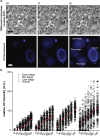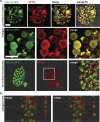Use of fluorescent nanoparticles to investigate nutrient acquisition by developing Eimeria maxima macrogametocytes
- PMID: 27352801
- PMCID: PMC4926162
- DOI: 10.1038/srep29030
Use of fluorescent nanoparticles to investigate nutrient acquisition by developing Eimeria maxima macrogametocytes
Abstract
The enteric disease coccidiosis, caused by the unicellular parasite Eimeria, is a major and reoccurring problem for the poultry industry. While the molecular machinery driving host cell invasion and oocyst wall formation has been well documented in Eimeria, relatively little is known about the host cell modifications which lead to acquisition of nutrients and parasite growth. In order to understand the mechanism(s) by which nutrients are acquired by developing intracellular gametocytes and oocysts, we have performed uptake experiments using polystyrene nanoparticles (NPs) of 40 nm and 100 nm in size, as model NPs typical of organic macromolecules. Cytochalasin D and nocodazole were used to inhibit, respectively, the polymerization of the actin and microtubules. The results indicated that NPs entered the parasite at all stages of macrogametocyte development and early oocyst maturation via an active energy dependent process. Interestingly, the smaller NPs were found throughout the parasite cytoplasm, while the larger NPs were mainly localised to the lumen of large type 1 wall forming body organelles. NP uptake was reduced after microfilament disruption and treatment with nocodazole. These observations suggest that E. maxima parasites utilize at least 2 or more uptake pathways to internalize exogenous material during the sexual stages of development.
Figures





Similar articles
-
Correlative light and electron microscopy of wall formation in Eimeria nieschulzi.Parasitol Res. 2020 Aug;119(8):2667-2678. doi: 10.1007/s00436-020-06765-6. Epub 2020 Jul 6. Parasitol Res. 2020. PMID: 32627078 Free PMC article.
-
F-actin distribution and function during sexual development in Eimeria maxima.Parasitology. 2015 Jun;142(7):855-64. doi: 10.1017/S0031182015000207. Epub 2015 Mar 24. Parasitology. 2015. PMID: 25800683
-
Differences in fecundity of Eimeria maxima strains exhibiting different levels of pathogenicity in its avian host.Vet Parasitol. 2017 Mar 15;236:1-6. doi: 10.1016/j.vetpar.2017.01.009. Epub 2017 Jan 17. Vet Parasitol. 2017. PMID: 28288751
-
Life cycle stages, specific organelles and invasion mechanisms of Eimeria species.Parasitology. 2020 Mar;147(3):263-278. doi: 10.1017/S0031182019001562. Epub 2019 Nov 18. Parasitology. 2020. PMID: 31727204 Free PMC article. Review.
-
The mannitol cycle in Eimeria.Parasitology. 1997;114 Suppl:S81-9. Parasitology. 1997. PMID: 9309770 Review.
Cited by
-
Proteomic Analysis of Fractionated Eimeria tenella Sporulated Oocysts Reveals Involvement in Oocyst Wall Formation.Int J Mol Sci. 2023 Dec 2;24(23):17051. doi: 10.3390/ijms242317051. Int J Mol Sci. 2023. PMID: 38069374 Free PMC article.
-
Proteomic analysis of protein interactions between Eimeria maxima sporozoites and chicken jejunal epithelial cells by shotgun LC-MS/MS.Parasit Vectors. 2018 Apr 4;11(1):226. doi: 10.1186/s13071-018-2818-4. Parasit Vectors. 2018. PMID: 29618377 Free PMC article.
-
Emerging Mechanisms of Endocytosis in Toxoplasma gondii.Life (Basel). 2021 Jan 25;11(2):84. doi: 10.3390/life11020084. Life (Basel). 2021. PMID: 33503859 Free PMC article. Review.
-
Correlative light and electron microscopy of wall formation in Eimeria nieschulzi.Parasitol Res. 2020 Aug;119(8):2667-2678. doi: 10.1007/s00436-020-06765-6. Epub 2020 Jul 6. Parasitol Res. 2020. PMID: 32627078 Free PMC article.
References
-
- Entzeroth R., Mattig F. R. & Werner-Meier R. Structure and function of the parasitophorous vacuole in Eimeria species. Int J Parasitol 28, 1015–1018 (1998). - PubMed
Publication types
MeSH terms
Substances
LinkOut - more resources
Full Text Sources
Other Literature Sources
Miscellaneous

